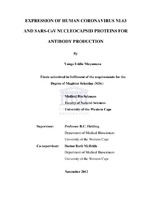| dc.contributor.advisor | Fielding, Burtram C. | |
| dc.contributor.advisor | McBride, Ruth | |
| dc.contributor.author | Mnyamana, Yanga Eddie | |
| dc.contributor.other | Dept. of Medical BioSciences | |
| dc.date.accessioned | 2014-03-13T12:25:41Z | |
| dc.date.available | 2013/08/08 | |
| dc.date.available | 2013/08/08 16:23 | |
| dc.date.available | 2014-03-13T12:25:41Z | |
| dc.date.issued | 2012 | |
| dc.identifier.uri | http://hdl.handle.net/11394/2989 | |
| dc.description | >Magister Scientiae - MSc | en_US |
| dc.description.abstract | Human Coronaviruses (HCoVs) are found within the family Coronaviridae (genus, Coronavirus) and are enveloped, single-stranded, positive-sense RNA viruses. Infections of humans by coronaviruses are not normally associated with severe diseases. However, the identification of the coronavirus responsible for the outbreak of severe acute respiratory syndrome (SARS-CoV) showed that highly pathogenic coronaviruses can enter the human population. The SARS-CoV epidemic resulted in 8 422 cases with 916 deaths globally (case fatality rate: 10.9%). In 2004 a group 1 Coronavirus, designated Human Coronavirus NL63 (HCoV-NL63), was isolated from a 7 month old Dutch child suffering from bronchiolitis. In addition, HCoV-NL63 causes disease in children (detected in approximately 10% of respiratory tract infections), the elderly and the immunocompromised. This study was designed to express the full length nucleocapsid (N) proteins of HCoV-NL63 and SARS-CoV for antibody production in an animal model. The NL63-N/pFN2A and SARSN/ pFN2A plasmid constructs were used for this study. The presence of the insert on the Flexi ® vector was confirmed by restriction endonuclease digest and sequence verification. The sequenced chromatographs obtained from Inqaba Biotec were consistent with sequences from the NCBI Gen_Bank. Proteins were expressed in a KRX Escherichia coli bacterial system and analysed using 15% SDS-PAGE and Western Blotting. Thereafter, GST-tagged proteins were purified ith an affinity column purification system. Purified fusion proteins were subsequently cleaved with Pro-TEV Plus protease, separated on 15% SDS-PAGE gel and stained with Coomassie Brilliant Blue R250. The viral fusion proteins were subsequently used to immunize Balbc mice in order to produce polyclonal antibodies. A direct ELISA was used to analyze and validate the production of polyclonal antibodies by the individual mice. This is a preliminary study for development of diagnostic tools for the detection of HCoV-NL63 from patient samples collected in the Western Cape. | en_US |
| dc.language.iso | en | en_US |
| dc.publisher | University of the Western Cape | en_US |
| dc.subject | Human coronavirus | en_US |
| dc.subject | Human coronavirus NL63 | en_US |
| dc.subject | Severe acute respiratory syndrome coronavirus | en_US |
| dc.subject | Nucleocapsid proteins | en_US |
| dc.subject | Antibodies | en_US |
| dc.subject | Protein expression | en_US |
| dc.subject | Antibody validation | en_US |
| dc.subject | Enzyme-Linked | en_US |
| dc.subject | Immunosorbent Assay | en_US |
| dc.subject | Viral antigens | en_US |
| dc.subject | MagneGST purification system | en_US |
| dc.title | Expression of human coronavirus NL63 and SARS-CoV nucleocapsid proteins for antibody production | en_US |
| dc.rights.holder | Copyright: University of the Western Cape | en_US |
| dc.description.country | South Africa | |

